Summary: in this tutorial, you will learn how to use the SQL Server GROUPING SETS to generate multiple grouping sets.
Setup a sales summary table
Let’s create a new table named sales.sales_summary for the demonstration.
SELECT
b.brand_name AS brand,
c.category_name AS category,
p.model_year,
round(
SUM (
quantity * i.list_price * (1 - discount)
),
0
) sales INTO sales.sales_summary
FROM
sales.order_items i
INNER JOIN production.products p ON p.product_id = i.product_id
INNER JOIN production.brands b ON b.brand_id = p.brand_id
INNER JOIN production.categories c ON c.category_id = p.category_id
GROUP BY
b.brand_name,
c.category_name,
p.model_year
ORDER BY
b.brand_name,
c.category_name,
p.model_year;
Code language: SQL (Structured Query Language) (sql)In this query, we retrieve the sales amount data by brand and category and populate it into the sales.sales_summary table.
The following query returns data from the sales.sales_summary table:
SELECT
*
FROM
sales.sales_summary
ORDER BY
brand,
category,
model_year;Code language: SQL (Structured Query Language) (sql)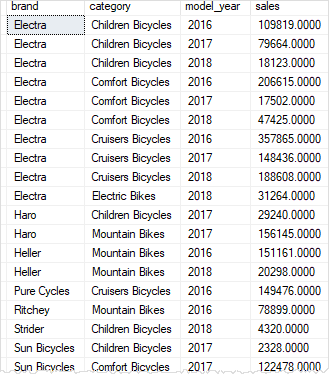
Getting started with SQL Server GROUPING SETS
By definition, a grouping set is a group of columns by which you group. Typically, a single query with an aggregate defines a single grouping set.
For example, the following query defines a grouping set that includes brand and category which is denoted as (brand, category). The query returns the sales amount grouped by brand and category:
SELECT
brand,
category,
SUM (sales) sales
FROM
sales.sales_summary
GROUP BY
brand,
category
ORDER BY
brand,
category;
Code language: SQL (Structured Query Language) (sql)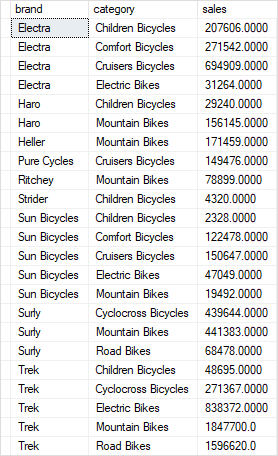
The following query returns the sales amount by brand. It defines a grouping set (brand):
SELECT
brand,
SUM (sales) sales
FROM
sales.sales_summary
GROUP BY
brand
ORDER BY
brand;Code language: SQL (Structured Query Language) (sql)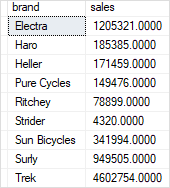
The following query returns the sales amount by category. It defines a grouping set (category):
SELECT
category,
SUM (sales) sales
FROM
sales.sales_summary
GROUP BY
category
ORDER BY
category;Code language: SQL (Structured Query Language) (sql)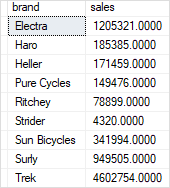
The following query defines an empty grouping set (). It returns the sales amount for all brands and categories.
SELECT
SUM (sales) sales
FROM
sales.sales_summary;Code language: SQL (Structured Query Language) (sql)
The four queries above return four result sets with four grouping sets:
(brand, category)
(brand)
(category)
()
Code language: SQL (Structured Query Language) (sql)To get a unified result set with the aggregated data for all grouping sets, you can use the UNION ALL operator.
Because UNION ALL operator requires all result sets to have the same number of columns, you need to add NULL to the select list of the queries like this:
SELECT
brand,
category,
SUM (sales) sales
FROM
sales.sales_summary
GROUP BY
brand,
category
UNION ALL
SELECT
brand,
NULL,
SUM (sales) sales
FROM
sales.sales_summary
GROUP BY
brand
UNION ALL
SELECT
NULL,
category,
SUM (sales) sales
FROM
sales.sales_summary
GROUP BY
category
UNION ALL
SELECT
NULL,
NULL,
SUM (sales)
FROM
sales.sales_summary
ORDER BY brand, category;Code language: SQL (Structured Query Language) (sql)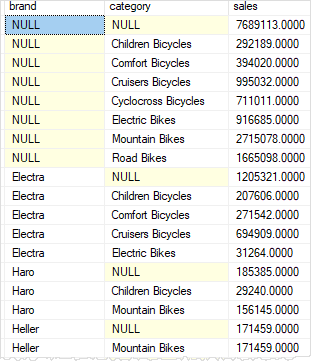
The query generated a single result with the aggregates for all grouping sets as we expected.
However, it has two major problems:
- The query is quite lengthy.
- The query is slow because the SQL Server needs to execute four subqueries and combine the result sets into a single one.
To fix these problems, SQL Server provides a subclause of the GROUP BY clause called GROUPING SETS.
The GROUPING SETS defines multiple grouping sets in the same query. The following shows the general syntax of the GROUPING SETS:
SELECT
column1,
column2,
aggregate_function (column3)
FROM
table_name
GROUP BY
GROUPING SETS (
(column1, column2),
(column1),
(column2),
()
);
Code language: SQL (Structured Query Language) (sql)This query creates four grouping sets:
(column1,column2)
(column1)
(column2)
()
Code language: SQL (Structured Query Language) (sql)You can use this GROUPING SETS to rewrite the query that gets the sales data as follows:
SELECT
brand,
category,
SUM (sales) sales
FROM
sales.sales_summary
GROUP BY
GROUPING SETS (
(brand, category),
(brand),
(category),
()
)
ORDER BY
brand,
category;Code language: SQL (Structured Query Language) (sql)As you can see, the query produces the same result as the one that uses the UNION ALL operator. However, this query is much more readable and of course more efficient.
GROUPING function
The GROUPING function indicates whether a specified column in a GROUP BY clause is aggregated or not. It returns 1 for aggregated or 0 for not aggregated in the result set.
See the following query example:
SELECT
GROUPING(brand) grouping_brand,
GROUPING(category) grouping_category,
brand,
category,
SUM (sales) sales
FROM
sales.sales_summary
GROUP BY
GROUPING SETS (
(brand, category),
(brand),
(category),
()
)
ORDER BY
brand,
category;Code language: SQL (Structured Query Language) (sql)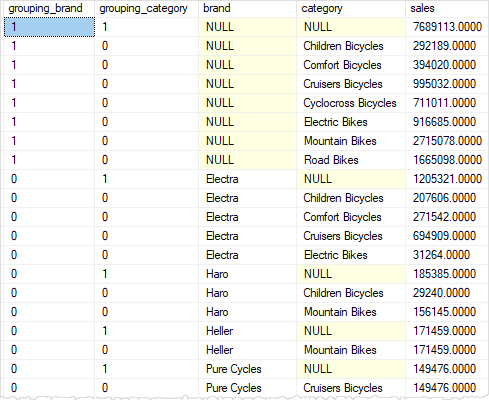
The value in the grouping_brand column indicates whether the row is aggregated or not:
- 1 means that the sales amount is aggregated by brand
- 0 means that the sales amount is not aggregated by brand.
The same logic is applied to the grouping_category column.
Summary
- Use the
GROUPING SETSto generate multiple grouping sets in a query.